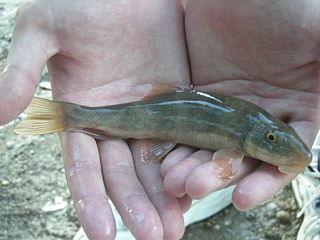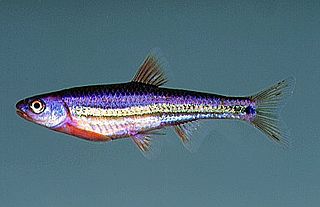
Gambusia is a large genus of viviparous fish in the family Poeciliidae. Gambusia contains over 40 species, most of which are principally found in freshwater habitats, though some species may also be found in brackish or saltwater habitats. The genus Gambusia comes from the Cuban term, "Gambusino", which means "free-lance miner". The type species is the Cuban gambusia, G. punctata. The greatest species richness is in Mexico, Texas, and the Greater Antilles, but species are also found elsewhere in the eastern and southern United States, the Bahamas, Central America, and Colombia. Gambusia species are often called topminnows, or simply gambusias; they are also known as mosquitofish, which, however, refers more specifically to two species, G. affinis and G. holbrooki, which are often introduced into ponds to eat mosquito larvae. As a consequence, they have been introduced widely outside their native range, and frequently become invasive, threatening local species. They are only occasionally kept in aquariums, due to their relative lack of color and the highly aggressive nature of the aforementioned mosquitofish species.

Rhinichthys, known as the riffle daces, is a genus of freshwater fish in the carp family (Cyprinidae) of the order Cypriniformes. The type species is Rhinichthys atratulus, the blacknose dace. Rhinichthys species range throughout North America.
The Independence Valley tui chub is a subspecies of tui chub endemic to the drainage of the Independence Valley in Elko County, northern Nevada.
The Mohave tui chub is a species of fish. It is an endangered chub originally found only in the Mojave River. Even though named after the Mojave River, the fish's name is normally spelled "Mohave". It was named by ichthyologist Robert Rush Miller.

Dionda is the genus of desert minnows, small fish belonging to the family Cyprinidae. They are native to fresh waters in the United States and Mexico. Their range is centered in the Rio Grande basin, but they also occur in associated systems, including Nazas–Aguanaval of north–central Mexico, and Nueces, San Antonio and Colorado of Texas.

Gila is a genus of fish belonging to the family Cyprinidae, native to the United States and Mexico. Species of Gila are collectively referred to as western chubs. The chiselmouth is a close relative, as are members of the genus Siphateles. Several members of the genus are endangered or extinct due to loss of habitat causing by diversion or overuse of water resources, particularly in the western United States.
The tui chub is a cyprinid fish native to western North America. Widespread in many areas, it is an important food source for other fish, including the cutthroat trout.

Lepidomeda is a genus of cyprinid fish, commonly known as the spinedaces, found in western North America. Of the four known species, one is extinct and two are threatened. They appear to be fairly close to the leatherside chub and the spikedaces, but the phylogeny and indeed the validity of the proposed "plagopterin" clade is insufficiently resolved.

Catostomus is a genus of fish belonging to the family Catostomidae, commonly known as suckers. Most members of the genus are native to North America, but C. catostomus is also found in Russia. Fish from different species of the genus are known to readily hybridize with each other.

Notropis is a genus of freshwater fish in the family Cyprinidae. They are known commonly as eastern shiners. They are native to North America, and are the continent's second largest genus.

Cyprinella is a genus of fish in the family Cyprinidae, the carps and minnows. They are known as the satinfin shiners. They are native to North America, and some are among the most common freshwater fish species on the eastern side of the continent. Conversely, several Cyprinella species with small distributions are threatened and the Maravillas Creek subspecies of the red shiner is extinct.

Erimystax is a genus of ray-finned fish in the family Cyprinidae. Members are commonly known as slender chubs, though "slender chub" is also used for individual species local to some area, particularly Erimystax cahni.

Hybognathus is a genus of ray-finned fish in the family Cyprinidae. Its members are collectively known as the silvery minnows. Hybognathus are pelagophils that are native to North America. The populations of such pelagophils, including species of Hybognathus, continue to decrease in their natural habitats.
Macrhybopsis, the blacktail chubs, is a genus of cyprinid fish that are found in North America. There are currently 12 species in this genus.
Squalius is a genus of fish in the family Cyprinidae found in Europe and Asia. Hybridization is not rare in the Cyprinidae, including this genus. S. alburnoides is known to be of ancient hybrid origin, with the paternal lineage deriving from a prehistoric species related to Anaecypris; the latter mated with ancestral S. pyrenaicus. Present-day S. alburnoides mates with sympatric congeners of other species.

Algansea is a genus of ray-finned fish in the family Leuciscidae, distributed in the Lerma–Chapala–Grande de Santiago, Pátzcuaro, Armería, Ameca, Ayutla and Tuxpan basins in west-central Mexico. The genus includes both species that are locally numerous, and species that are highly threatened. Their closest relative is the longfin dace.

Leuciscinae is a subfamily of the freshwater fish family Cyprinidae, which contains the true minnows.

Hybopsis is a genus of cyprinid fish endemic to the United States. There are currently six described species in this genus.
Tampichthys is a genus of cyprinid fish endemic to east–central Mexico. They are entirely restricted to the Pánuco River basin, except T. ipni which also occurs in some other Mexican rivers that drain into the Gulf of Mexico.

The Owens tui chub was described in 1973 as a subspecies of tui chub endemic to the Owens River Basin in Eastern California, United States. The Owens tui chub is distinguished from its closest relative, the Lahontan tui chub, by scales with a weakly developed or absent basal shield, 13 to 29 lateral and apical radii, also by the structure of its pharyngeal arches, the number of anal fin rays, 10 to 14 gill rakers, and 52 to 58 lateral line scales. Dorsal and lateral coloration varies from bronze to dusky green, grading to silver or white on the belly. It may reach a total length of 30 centimetres (12 in). Owens tui chub are believed to be derived from Lahontan Basin tui chub that entered the Owens Basin from the north during the Pleistocene Epoch.














